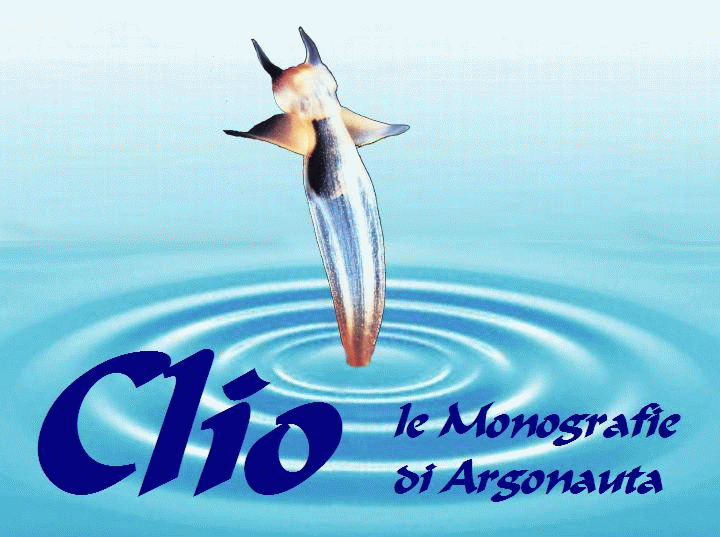
Clio supplemento a Argonauta n. 1-6 2012
 |
 |
|
Perron (1978), che ha esaminato molti aspetti interessanti su A. occidentalis, ha considerato, durante le sue osservazioni, due tipi distinti di locomozione riferiti alle forme giovanili ed alle forme adulte. Lo stesso Perron (1978) considera una leap locomotion (Aporrhais adulti) ed una lunge locomotion (Aporrhais giovani). Per effetto della mancanza di appendici, i giovani Aporrhais si comportano diversamente nella locomozione. Durante il movimento estendono il propodium (parte anteriore del piede) in avanti, mentre la conchiglia rimane ferma sul substrato. La successiva distensione del piede la trascina, in avanti facendola avanzare. Da ciò deriva uno strano procedere della conchiglia che, ad intervalli regolari non viene spinta, ma trascinata in avanti dalla parte distale del piede che dallo stato di tensione passa a quello di distensione riavvicinandosi al propodium. In conclusione il movimento della conchiglia non è altro che il risultato della tensione del piede al quale consegue il ripristino della posizione di riposo. La vita sotto il substrato – il sistema del burrowingOsservazioni in vivo degli Aporrhais hanno dimostrato che questi esseri possono condurre una vita al di sotto del substrato, insabbiandosi completamente. In merito a questo singolare aspetto, esistono una serie di considerazioni strettamente legate alla loro bio-ecologia.Gli aspetti più interessanti si evidenziano nel metodo che l'animale usa per insabbiarsi; nella capacità di potersi alimentare in situ; nella possibilità o meno di poter attuare comunque una locomozione anche attraverso il substrato e se considerare il periodo di vita nel substrato come fattore occasionale o stagionale. Se possiamo affermare che la morfologia conchiliare degli Aporrhais provoca una serie di difficoltà nel bilanciamento della conchiglia medesima e nella sua locomozione, nel ribaltamento e nel suo insabbiarsi (burrowing) la conchiglia sembra invece dimostrare la sua perfetta rispondenza a tale necessità. Per quanto concerne il burowíng degli Aporrhais è necessario fare qualche passo indietro per analizzare esaurientemente questo fenomeno. Bisogna innanzi tutto evidenziare che gli Aporrhais non sono gli unici molluschi capaci di condurre una vita al di sotto del substrato. Yonge (1946) ha esaminato il sistema di alimentazione della Turritella durante il burrowing, Morton (1951) quello della Struthiolaria ed Abbott (1962). quello del Terebellum terebellum (Linnaeus, 1758). Percharde (1970) ha descritto il comportamento di alcuni strombi come S. pugilis, S. alatus e S. raninus durante vari periodi dell'anno. Più recenti studi di Berg (1974) e Perron (1978) hanno dimostrato che esiste una correlazione tra i vari sistemi di locomozione della Stromboidea in genere: sistemi che vanno dalle forme primitive degli Aporrhais e delle Struthiolarie ai più evoluti sistemi di locomozione dei Generi Strombus (Linnaeus, 1758) e Lambis Röding, 1798. Osservando il metodo del burrowing degli Aporrhais, appare evidente che il mollusco è specializzato per tale attività. Dopo qualche movimento inteso ad esaminare la natura del substrato, il mollusco attua il burrowing. |
Perron (1978), who has exsamined many interesting aspects of A. occidentalis considered during his observations two distinct types of locomotion with reference to juvenile and adult forms. Perron (1978) considers a leap locomotion (adult Aporrhais) and a lunge locomotion (juvenile Aporrhais). On account of the lack of appendices, the young Aporrhais behave differently in locomotion. During the movement they extend forwards the propodium (the front part of the foot), while the shell stays put in the substratum. The subsequent relaxation of the foot drags the shell forwards thus making it advance. From this derives a strange progress of the shell which at regular intervals is not pushed but dragged forwards by the distal part of the foot which passes from a state of tension to one of relaxation nearing itself to the propodium. In conclusion the movement of the shell is none other than the result of the tension of the foot which is followed by the return to the position of rest. Life below the substratum - The burrowing systemObservation of living Aporrhais has shown that these creatures can lead a life beneath the substratum, completely burrowed into the sand. There are a series of considerations strictly reIated to their bio-ecology regarding this singuIar aspect. The most interesting elements derive from the method which the animaI uses for burrowing; the capacity for alimentation in situ; whether or not there is a possibility of achieving any Iocomotion through the substratum, and whether the period passed in the substratum should be considered as an occasionaI or a seasonal factor. If we can state that the shell morphology of the Aporrhais causes a series of difficulties in the balancing, Iocomotion and overturning, we can certainly not say the same about its burrowing, in that the morphology of the shell itself seems to show its perfect suitability for such a necessity. As far as the burrowing of the Aporrhais is concerned it is necessary to go back a little in order to analyse this phenomenon thoroughly. We must first point out that the Aporrhais are not the only molluscs capable of living a Iife beneath the substratum. Yonge (1946) has examined the system of Turritella alimentation during burrowing; Morton (1951) that of Struthiolaria and Abbott (1962) that of Terebellum terebellum Linnaeus, 1758. Percharde (1970) has described the behaviour of some strombids such as S. pugilis, S. alatus and S. raninus during the various periods of the year. More recent studies by Berg (1974) and Perron (1978) have shown that there exists a relationship between the various system of Iocomotion of the Stromboidea generally; systems which go from the primitive forms of the Aporrhais and the Struthiolarids to more evoluted systems of locomotion of the genera Strombus (Linneaeus, 1758) and Lambis Röding, 1798. Observing the method of burrowing of the Aporrhais, it appears obvious that the mollusc is specialised in this activity. After a few movements meant to examine the nature of the substratum, the mollusc starts burrowing. |
